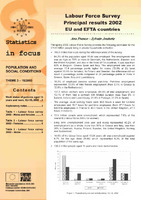| dc.contributor.author | Eurostat |
| dc.date.accessioned | 2020-12-18T13:22:13Z |
| dc.date.available | 2020-12-18T13:22:13Z |
| dc.date.issued | 2003 |
| dc.identifier.isbn | 1024-4352 |
| dc.identifier.uri | https://ketlib.lib.unipi.gr/xmlui/handle/ket/3480 |
| dc.description | Downloaded from EU Bookshop. |
| dc.description | EUROSTAT:THEME 3:STATISTICS IN FOCUS/RAPID REPORTS:Industry and Services: Labour Market; Costs; Earnings; Wages; Working Conditions, etc. |
| dc.description | http://aei.pitt.edu/id/eprint/85467 |
| dc.description.abstract | The spring 2002 Labour Force Survey provides the following estimates for the 374.8 million people living in private households in the EU: > 163.0 million had a job during the reference week of the survey: - 64.2% of the population aged 15-64 was employed. The employment rate was as high as 70% or more in Denmark, the Netherlands, Sweden and the United Kingdom, and also in the three EFTA countries. It was less than 60% in Belgium, Greece Spain and Italy. The employment rate was on average 17.4 percentage points higher for males (72.9% at EU level against 55.5% for females). In Finland and Sweden, the difference did not reach 4 percentage points compared to 24 percentage points or more in Greece, Spain, Italy and Luxembourg. |
| dc.format.extent | 8p. |
| dc.language.iso | en |
| dc.publisher | Eurostat |
| dc.subject | Employment |
| dc.subject | Labor Market |
| dc.subject | Social Conditions |
| dc.title | Statistics in Focus: Population and social conditions. Labour Force Survey Principal results 2002 EU and EFTA countries. 2003 |
| dc.type | working document |
| dc.publisher.place | Luxemburg |

